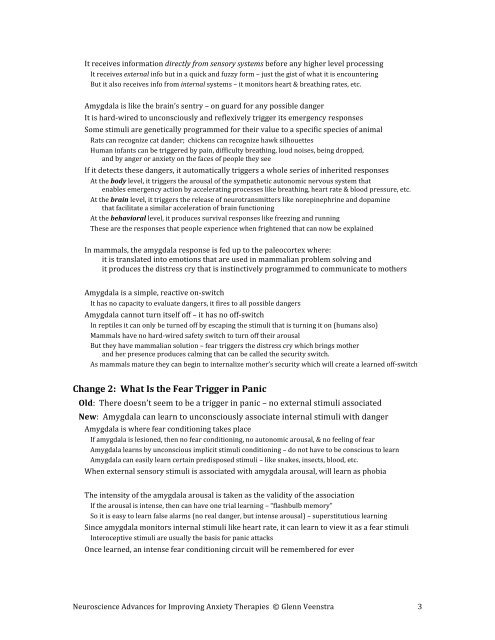Veenstra 170 - Anxiety Disorders Association of America
Veenstra 170 - Anxiety Disorders Association of America
Veenstra 170 - Anxiety Disorders Association of America
You also want an ePaper? Increase the reach of your titles
YUMPU automatically turns print PDFs into web optimized ePapers that Google loves.
It receives information directly from sensory systems before any higher level processing<br />
It receives external info but in a quick and fuzzy form – just the gist <strong>of</strong> what it is encountering<br />
But it also receives info from internal systems – it monitors heart & breathing rates, etc.<br />
Amygdala is like the brain’s sentry – on guard for any possible danger<br />
It is hard-‐wired to unconsciously and reflexively trigger its emergency responses<br />
Some stimuli are genetically programmed for their value to a specific species <strong>of</strong> animal<br />
Rats can recognize cat dander; chickens can recognize hawk silhouettes<br />
Human infants can be triggered by pain, difficulty breathing, loud noises, being dropped,<br />
and by anger or anxiety on the faces <strong>of</strong> people they see<br />
If it detects these dangers, it automatically triggers a whole series <strong>of</strong> inherited responses<br />
At the body level, it triggers the arousal <strong>of</strong> the sympathetic autonomic nervous system that<br />
enables emergency action by accelerating processes like breathing, heart rate & blood pressure, etc.<br />
At the brain level, it triggers the release <strong>of</strong> neurotransmitters like norepinephrine and dopamine<br />
that facilitate a similar acceleration <strong>of</strong> brain functioning<br />
At the behavioral level, it produces survival responses like freezing and running<br />
These are the responses that people experience when frightened that can now be explained<br />
In mammals, the amygdala response is fed up to the paleocortex where:<br />
it is translated into emotions that are used in mammalian problem solving and<br />
it produces the distress cry that is instinctively programmed to communicate to mothers<br />
Amygdala is a simple, reactive on-‐switch<br />
It has no capacity to evaluate dangers, it fires to all possible dangers<br />
Amygdala cannot turn itself <strong>of</strong>f – it has no <strong>of</strong>f-‐switch<br />
In reptiles it can only be turned <strong>of</strong>f by escaping the stimuli that is turning it on (humans also)<br />
Mammals have no hard-‐wired safety switch to turn <strong>of</strong>f their arousal<br />
But they have mammalian solution – fear triggers the distress cry which brings mother<br />
and her presence produces calming that can be called the security switch.<br />
As mammals mature they can begin to internalize mother’s security which will create a learned <strong>of</strong>f-‐switch<br />
Change 2: What Is the Fear Trigger in Panic<br />
Old: There doesn’t seem to be a trigger in panic – no external stimuli associated<br />
New: Amygdala can learn to unconsciously associate internal stimuli with danger<br />
Amygdala is where fear conditioning takes place<br />
If amygdala is lesioned, then no fear conditioning, no autonomic arousal, & no feeling <strong>of</strong> fear<br />
Amygdala learns by unconscious implicit stimuli conditioning – do not have to be conscious to learn<br />
Amygdala can easily learn certain predisposed stimuli – like snakes, insects, blood, etc.<br />
When external sensory stimuli is associated with amygdala arousal, will learn as phobia<br />
The intensity <strong>of</strong> the amygdala arousal is taken as the validity <strong>of</strong> the association<br />
If the arousal is intense, then can have one trial learning – “flashbulb memory”<br />
So it is easy to learn false alarms (no real danger, but intense arousal) – superstitutious learning<br />
Since amygdala monitors internal stimuli like heart rate, it can learn to view it as a fear stimuli<br />
Interoceptive stimuli are usually the basis for panic attacks<br />
Once learned, an intense fear conditioning circuit will be remembered for ever<br />
Neuroscience Advances for Improving <strong>Anxiety</strong> Therapies © Glenn <strong>Veenstra</strong> 3


